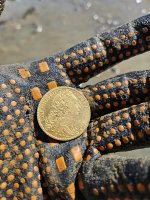Hey Everyone,
I recently acquired two pieces in a specimen box with labels from a collector's estate who had passed away. As you can see from the old, typed labels in the photos, one is identified as a Clovis and the other Kirk. Both also show the locations where found and material. This is not my area of expertise (not even certain the tags are not switched up) so wanted to check with the enthusiasts on this board if there are any indications whether these are Paleo or of recent making.
Greatly appreciate any help!
TIA!
Mike








I recently acquired two pieces in a specimen box with labels from a collector's estate who had passed away. As you can see from the old, typed labels in the photos, one is identified as a Clovis and the other Kirk. Both also show the locations where found and material. This is not my area of expertise (not even certain the tags are not switched up) so wanted to check with the enthusiasts on this board if there are any indications whether these are Paleo or of recent making.
Greatly appreciate any help!
TIA!
Mike
Upvote
8




